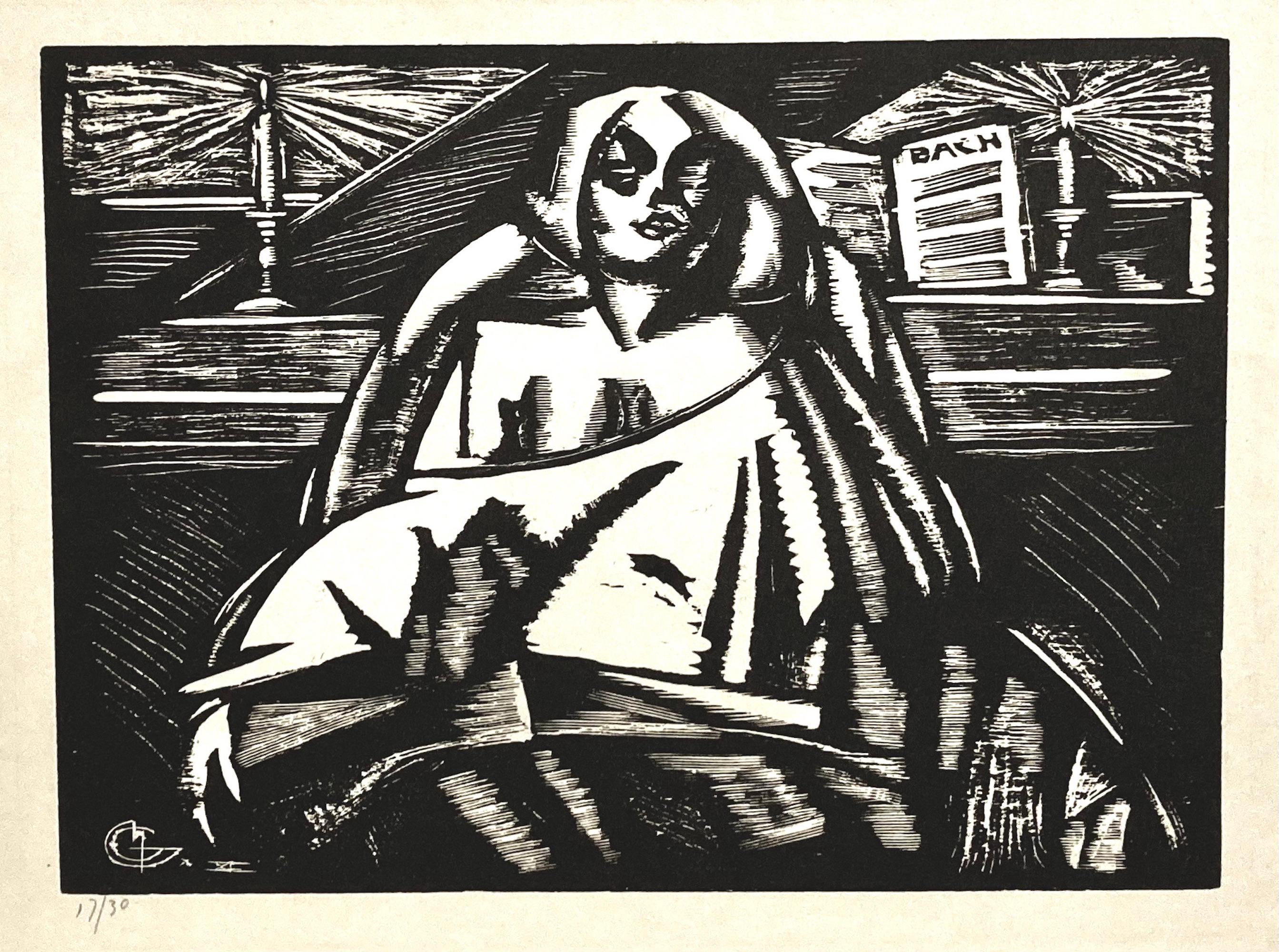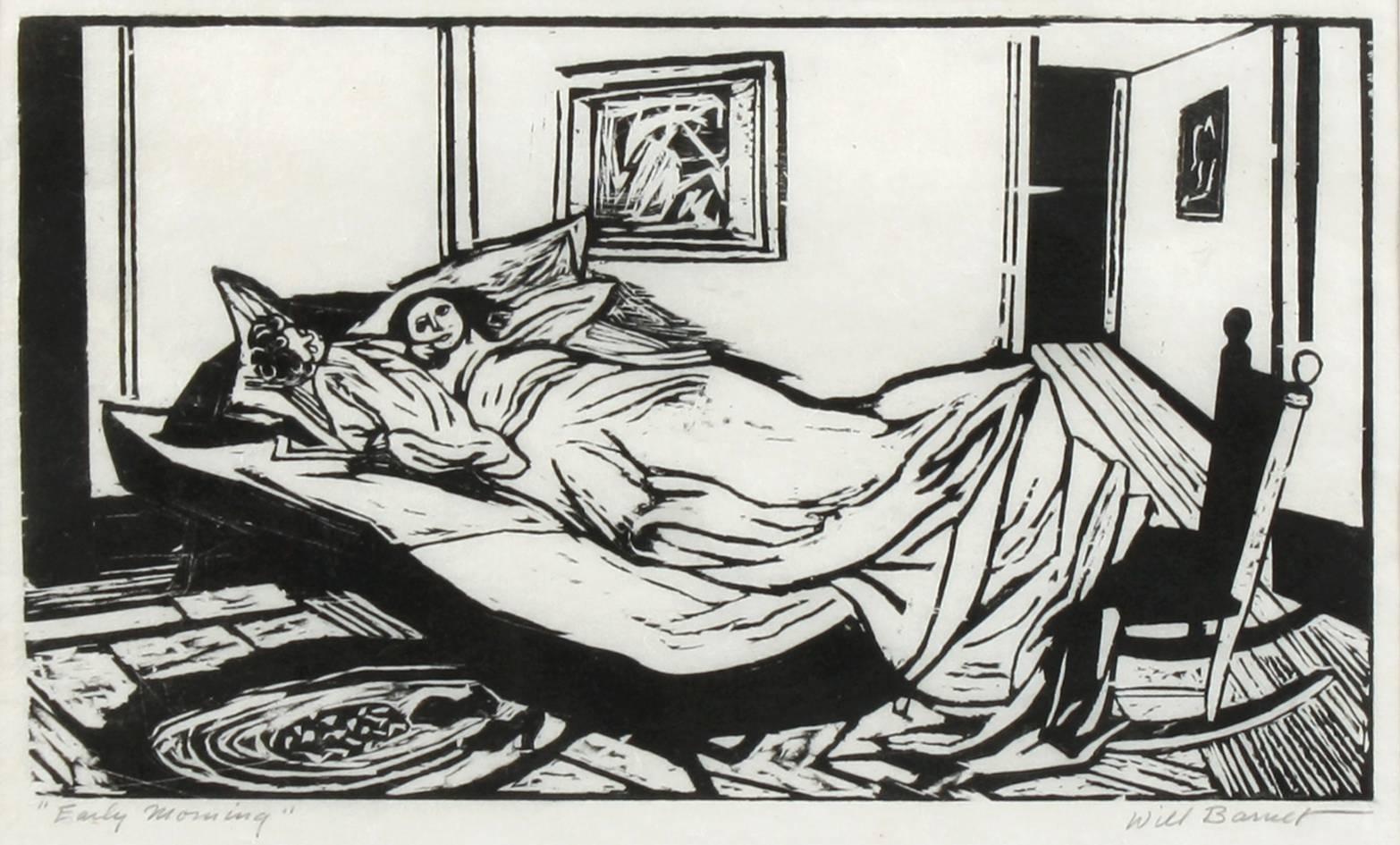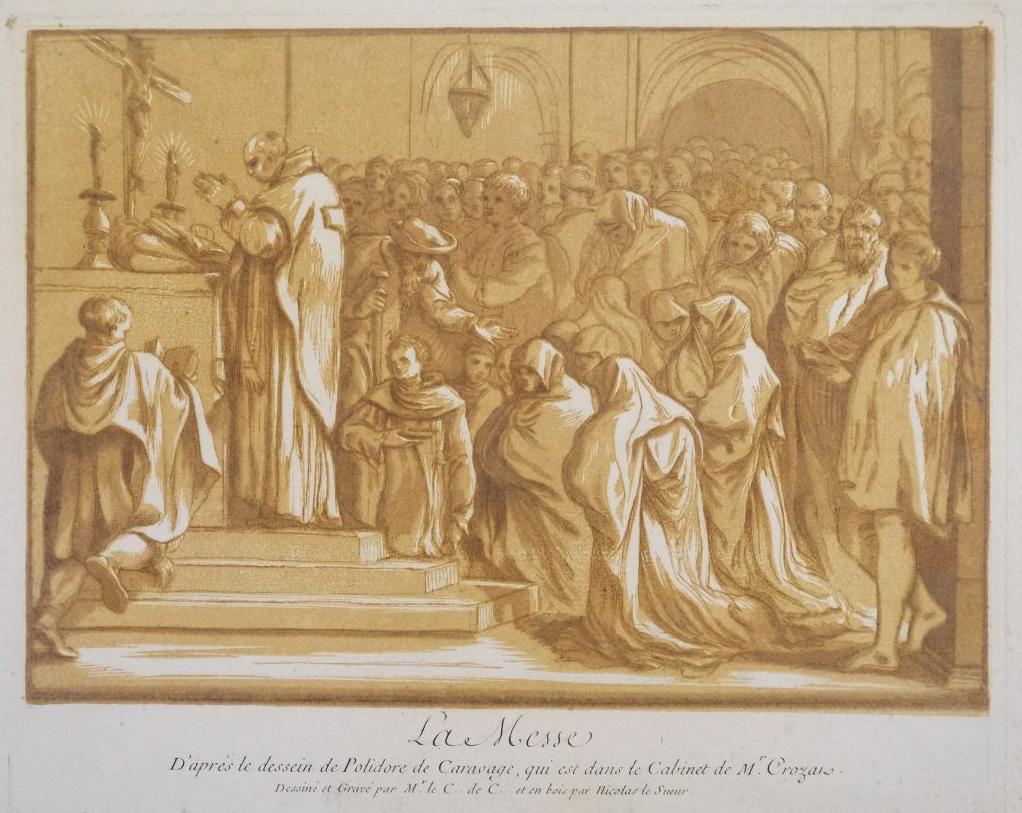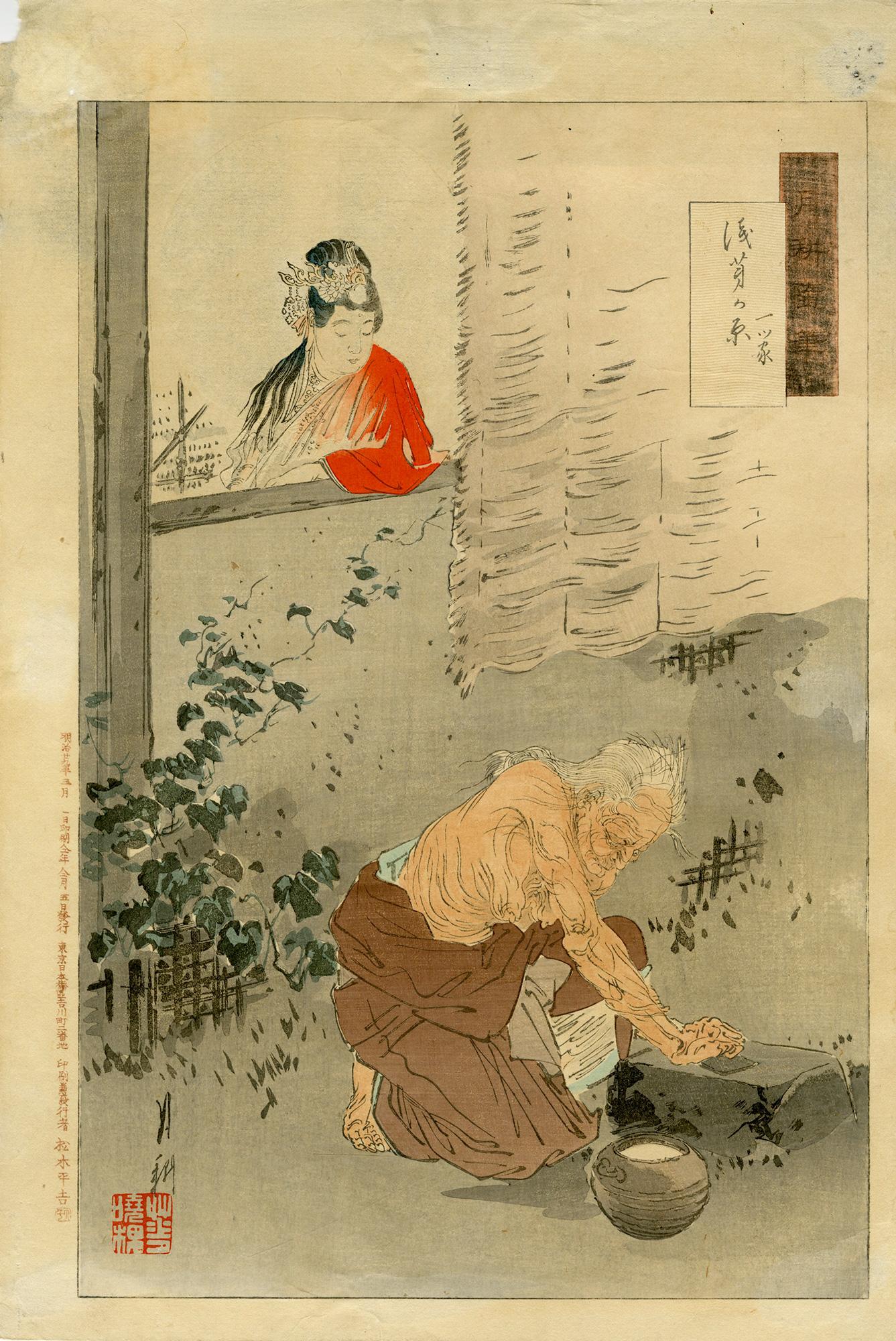Items Similar to 'Interior of the Kannon Temple at Asakusa' — Early Edition 1930s Woodblock Print
Want more images or videos?
Request additional images or videos from the seller
1 of 3
NARAZAKI EISHO'Interior of the Kannon Temple at Asakusa' — Early Edition 1930s Woodblock Print1932
1932
About the Item
NARAZAKI EISHO (1864-1936), 'Asakusa Kannon-do no naido' (Interior of the Kannon Temple at Asakusa), color woodblock print, 1932. Signed Eisho lower right, with the artist’s red seal beneath. A fine impression with fresh colors; the full sheet with slight overall age toning, a drying tack hole in the upper left margin, in overall excellent condition.
Vertical oban: image size 14 3/16 x 9 9/16 inches (360 x 243 mm); sheet size 15 1/4 x 10 1/2 inches (387 x 267 mm).
Published by Watanabe Shozaburo. A rare first or early edition impression with the Watanabe publisher’s seal “C” (1929-1942) in the lower left margin and the title and date in the lower right margin.
Collections: Harvard Art Museums, Los Angeles County Museum of Art, Museum of Fine Arts Boston.
Literature: 'Shin-Hanga: New Prints in Modern Japan,' Kendall Brown, Hollis Goodall-Cristante, Los Angeles County Museum of Art, 1996, p. 83, figure 113; 'Japanese Wood-block Prints,' Shizuya Fujikake, Japan Travel Bureau, 1938, p. 94, 95; 'The Legacy of Japanese Printmaking,' Barry Till, Art Gallery of Greater Victoria, 1986, plate 62; 'Modern Japanese Prints: The Twentieth Century,' Amanda T. Zehnder, Carnegie Museum of Art, 2009, p. 132; 'Hanga ni miru Tokyo no fukei; Kanto daishinsai kara senzen made, Ota Kuritsu Kyodo Hakubutsukan,' 2002, pl. 213, p. 50.
ABOUT THE IMAGE
The scene depicted is of the interior of the Asakusa Kannon Temple on New Year’s Day. Large celebratory lanterns hang from the high ceiling; the one in the foreground bears a 17th-century Buddhist symbol. The Buddhist temple Sensōji, also known as Asakusa Kannon Temple, is located in Asakusa, Tokyo. Completed in 645 AD, it is Tokyo's oldest temple and one of its most colorful and popular.
ABOUT THE ARTIST
Narazaki Eishō (1864-1936) was born in Edo (modern-day Tokyo), Japan. He was a highly esteemed artist known for his mastery of the traditional Japanese woodblock print technique, ukiyo-e. Eishō's life and work spanned a transformative period in Japanese history, witnessing the transition from the Edo period to the Meiji era and the subsequent modernization of Japan.
Eishō initially trained under the guidance of his father, Narazaki Kōgyo, a well-known artist and printmaker. Under his father's tutelage, Eishō honed his skills in woodblock printing and developed a deep appreciation for the rich artistic traditions of Japan. He demonstrated remarkable talent from a young age, quickly gaining recognition for his intricate designs and meticulous craftsmanship.
As Japan underwent rapid modernization and cultural shifts during the Meiji era, Eishō remained committed to preserving and revitalizing the art of ukiyo-e, which was facing challenges from Western influences and changing tastes. He drew inspiration from classical ukiyo-e masters, such as Hokusai and Hiroshige, and contemporary trends in Japanese art, blending traditional techniques with innovative approaches.
Eishō's prints, celebrated for their beauty, craftsmanship, and evocative portrayal of Japanese life and culture, encompassed various subjects, including landscapes, portraits, historical scenes, and depictions of kabuki actors and geisha. He demonstrated a keen eye for capturing the beauty and dynamism of everyday life in Japan, infusing his prints with vibrant colors, intricate details, and a sense of elegance and refinement.
One of Eishō's notable achievements was his collaboration with the publisher Watanabe Shōzaburō, who played a pivotal role in the revival of ukiyo-e during the early 20th century. Together, they produced a series of prints featuring famous landmarks, scenic views, and traditional customs of Japan, which gained popularity both domestically and internationally.
Throughout his career, Eishō remained dedicated to the preservation and promotion of ukiyo-e as a vital art form. He also contributed to the scholarly study of Japanese prints, publishing books and articles on the history and techniques of ukiyo-e.
Eishō's prints are represented in the collections of the Art Institute of Chicago, Carnegie Museum of Art, Georgetown University, Harvard Art Museums, University of Wisconsin, The Lavenberg Collection of Japanese Prints, and the Philadelphia Museum of Art.
- Creator:NARAZAKI EISHO (1864 - 1936, Japanese)
- Creation Year:1932
- Dimensions:Height: 14.188 in (36.04 cm)Width: 9.563 in (24.29 cm)
- Medium:
- Period:
- Condition:
- Gallery Location:Myrtle Beach, SC
- Reference Number:
About the Seller
5.0
Recognized Seller
These prestigious sellers are industry leaders and represent the highest echelon for item quality and design.
Platinum Seller
These expertly vetted sellers are 1stDibs' most experienced sellers and are rated highest by our customers.
Established in 1995
1stDibs seller since 2016
254 sales on 1stDibs
Typical response time: 2 hours
Associations
International Fine Print Dealers Association
- ShippingRetrieving quote...Ships From: Myrtle Beach, SC
- Return PolicyA return for this item may be initiated within 7 days of delivery.
More From This SellerView All
- Mosque of the Sultan Bayazid, ConstantinopleBy Louis Conrad RosenbergLocated in Myrtle Beach, SCLouis Conrad Rosenberg, 'Mosque of the Sultan Bayazid, Constantinople', etching, 1927. Signed in pencil. Initialed and dated in the plate, lower left. A fine, richly-inked impression...Category
1920s American Realist Figurative Prints
MaterialsDrypoint
- 'The Bather' — 1930s American ModernismBy Rockwell KentLocated in Myrtle Beach, SCRockwell Kent, 'The Bather', wood engraving, 1931, edition 120, Burne Jones 63. Signed in pencil. A brilliant, black impression, on cream, wove Japan paper; the full sheet with margins (2 1/2 to 3 1/4 inches); slight skinning at the top sheet edge, verso, otherwise in excellent condition. Image size 5 3/8 x 7 7/8 inches (137 x 200 mm); sheet size 11 1/8 x 14 1/2 inches (283 x 368 mm). Archivally matted to museum standards, unframed. Impressions of this work are held in the following public collections: Burne Jones Collection, IL; Chegodaev Collection, Moscow; Kent Collection, NY; Philadelphia Museum of Art; Princeton University Library, NJ; Pushkin Museum, Moscow; Smithsonian American Art Museum, Spector Collection, NY. Rockwell Kent (1882-1971), though best known as a painter, graphic artist, and illustrator, pursued many careers throughout his life, including architect, carpenter, explorer, writer, dairy farmer, and political activist. Born in Tarrytown, New York, Kent was interested in art from a young age. These ambitions were encouraged by his aunt Jo Holgate, an accomplished ceramicist. Jo came to live with the family after Kent’s father passed away in 1887 and took him to Europe as a teenager, undoubtedly kindling his interest in exploring the world. Kent attended the Horace Mann School in New York City, where he excelled at mechanical drawing. His family’s financial circumstances prevented him from pursuing a career in the fine arts; however, after graduating from Horace Mann in 1900, Kent decided to study architecture at Columbia University. Before matriculating at Columbia, Kent spent the first of three consecutive summers studying painting at William Merritt Chase’s art school in Shinnecock Hills, Long Island. There he found a community of mentors and fellow students who encouraged him to pursue his interest in art. At the end of Kent’s third summer at Shinnecock, Chase offered him a full scholarship to the New York School of Art, where he was a teacher. Kent began taking night classes at the art school in addition to his architecture studies but soon left Columbia to study painting full-time. In addition to Chase, Kent took classes with Robert Henri and Kenneth Hayes Miller, where his classmates included the artists George Bellows and Edward Hopper. Kent spent the summer of 1903 assisting the eccentric painter Abbott Handerson Thayer at his studio in Dublin, New Hampshire—a position he secured through the recommendation of his Aunt Jo. Thayer’s naturalist lifestyle and almost mystical appreciation for natural phenomena greatly influenced Kent; he returned to Dublin for many years to visit Thayer and his family. Thayer gave the young artist time to pursue his work, and that summer Kent painted several views of the New Hampshire landscape, including Mount Monadnock...Category
1930s American Modern Nude Prints
MaterialsWoodcut
- Flowering Quince and Cantonese Buttercup, Siskin — 19th century woodblock printLocated in Myrtle Beach, SCImao Keinen, 'Flowering Quince and Cantonese Buttercup, Siskin' from the series 'Birds and Flowers of the Four Seasons', color woodblock Oban diptych, 1882. A fine impression, with fresh colors, on cream Japan paper, in excellent condition. Image size: diptych 12 5/8 x 17 7/8 inches (321 x 452 mm). Archivally sleeved, unmatted. ABOUT THE ARTIST Born in Kyoto, Imao Keinen (1845-1924) studied painting and calligraphy with Umegata Tokyo and Suzuki Hyakunen. He taught at the Kyoto Prefecture School of Painting and exhibited in shows in Japan and Paris. One of the most well-known Japanese painters of his time, Keinen was honored by his country with the title of 'Artist of the Japanese Empire...Category
1880s Naturalistic Figurative Prints
MaterialsWoodcut
- Cabbage Rose and Spotted Munia— 19th century woodblock printLocated in Myrtle Beach, SCImao Keinen, 'Cabbage Rose and Spotted Munia' from the series 'Birds and Flowers of the Four Seasons', color woodblock Oban diptych, 1882. A fine impression, with fresh colors, on cream Japan paper, in excellent condition. Image size: diptych 12 5/8 x 17 7/8 inches (321 x 452 mm). Archivally sleeved, unmatted. ABOUT THE ARTIST Born in Kyoto, Imao Keinen (1845-1924) studied painting and calligraphy with Umegata Tokyo and Suzuki Hyakunen. He taught at the Kyoto Prefecture School of Painting and exhibited in shows in Japan and Paris. One of the most well-known Japanese painters of his time, Keinen was honored by his country with the title of 'Artist of the Japanese Empire...Category
1880s Naturalistic Figurative Prints
MaterialsWoodcut
- Tree Peony and Blue and White Flycatcher — 19th century woodblock printLocated in Myrtle Beach, SCImao Keinen, 'Tree Peony and Blue and White Flycatcher' from the series 'Birds and Flowers of the Four Seasons', color woodblock Oban dipty...Category
1880s Naturalistic Figurative Prints
MaterialsWoodcut
- Japanese Flowering Cherry and Mugimaki Flycatcher — 19th century woodblock printLocated in Myrtle Beach, SCImao Keinen, 'Japanese Flowering Cherry and Mugimaki Flycatcher' from the series 'Birds and Flowers of the Four Seasons', color woodblock Oban diptych, 1882. A fine impression, with fresh colors, on cream Japan paper, in excellent condition. Image size: diptych 12 5/8 x 17 7/8 inches (321 x 452 mm). Archivally sleeved, unmatted. ABOUT THE ARTIST Born in Kyoto, Imao Keinen (1845-1924) studied painting and calligraphy with Umegata Tokyo and Suzuki Hyakunen. He taught at the Kyoto Prefecture School of Painting and exhibited in shows in Japan and Paris. One of the most well-known Japanese painters of his time, Keinen was honored by his country with the title of 'Artist of the Japanese Empire...Category
1880s Naturalistic Figurative Prints
MaterialsWoodcut
You May Also Like
- Heinrich Glintenkamp, (Woman at Piano - Bach)By Heinrich GlintenkampLocated in New York, NYAn American painter, printmaker, and illustrator. His work was featured in "The Masses" and at the Metropolitan Museum of Art and Pennsylvania Academy of the Fine Arts. This wood en...Category
Mid-20th Century American Modern Interior Prints
MaterialsWoodcut
- Albert Abramovitz, The Wagonette (Moscow Subway)By Albert AbramovitzLocated in New York, NYAlbert Abramovitz was working in New York in the 1930s when he made wood engravings of the construction of the Moscow subway. This image, The Wagonette, is a wrenching testament to t...Category
1930s Ashcan School Interior Prints
MaterialsWoodcut
- Early MorningBy Will BarnetLocated in Buffalo, NYA nice rare woodcut by the noted American Artist Will Barnet. This woodcut is from 1939 and is titled and pencil signed on the base "Early Morning", Will...Category
1930s American Modern Figurative Prints
MaterialsPaper, Woodcut
- Dickie (Child in High Chair)By Will BarnetLocated in Buffalo, NYAn original woodcut on japan paper created by master American artist Will Barnet in 1942.Category
1940s American Modern Figurative Prints
MaterialsPaper, Woodcut
- La Messe (The Mass), after CaravaggioLocated in Middletown, NYChiaroscuro woodcut with underlying engraving on cream laid paper, printed from two blocks in brown and olive. 10 1/4 x 12 3/4 inches (260 x 321 mm) (plate), full margins with the text printing clearly below in black ink. In very good condition with scattered surface soiling and several minor flecks of light discoloration in the margins, especially in the area of the lower right corner, well outside of image area. Unobtrusive notations in pencil in the margin and on the verso. All condition issues are consistent with age. After a drawing of the same title by Polidoro da Caravaggio...Category
Mid-18th Century Old Masters Figurative Prints
MaterialsLaid Paper, Engraving, Woodcut
- Atelier No 7, Contemporary WoodcutBy Arturo Di StefanoLocated in Brecon, PowysFrom the Stoneman collection Arturo DI Stefano has shown work in many galleries worldwide including: *Purdy Hicks Gallery London 1998-99, *Eastbourne Clark Gallery, Florida 1991, ...Category
1980s Modern Interior Prints
MaterialsWoodcut





